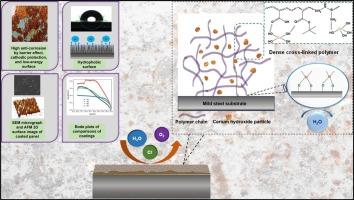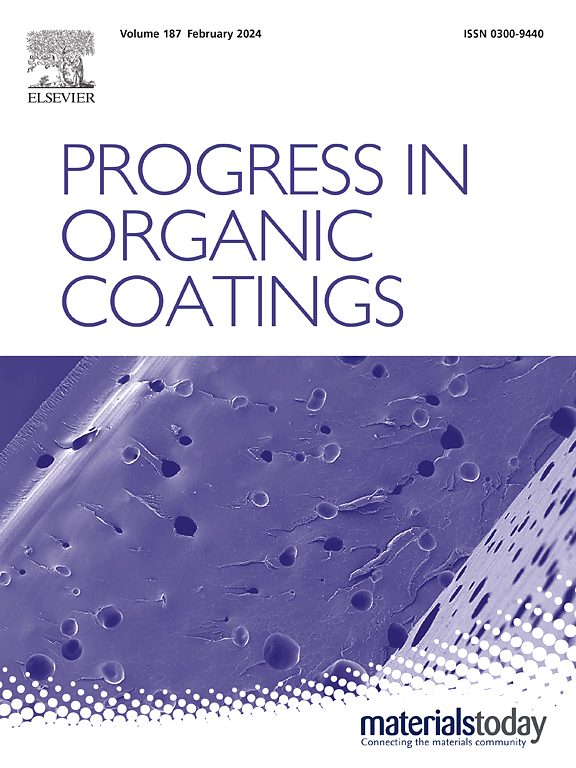Corrosion protection of mild steel via cerium nitrate loaded acrylic-vinyl polysilazane based hybrid coatings
IF 6.5
2区 材料科学
Q1 CHEMISTRY, APPLIED
引用次数: 0
Abstract
This study presents an efficient anticorrosive coating based on an organic-inorganic hybrid polymer composed of methyl methacrylate, styrene, tert-butyl acrylate, and vinyl polysilazane. The synthesized resin exhibits excellent thermal resistance and stability, as confirmed by thermogravimetric analysis (TGA). Additionally, leveraging the resin's highly alkaline nature, cerium oxide (CeO2) nanoparticles were doped in situ within the polymer matrix. The hybrid resins were subsequently applied to mild steel panels using a dip-coating technique. The resulting coatings are transparent, flexible, thin, pore-free, and possess low surface roughness (<2.62 nm), along with good thermal stability (>350 °C). Their remarkable anticorrosive performance and durability are attributed to forming a highly crosslinked acrylic-polysilazane network, combined with a cerium oxide protective barrier layer that adheres to the substrate. Furthermore, the cerium ions suppress both cathodic and anodic corrosion reactions, enhancing the corrosion resistance. Notably, the coating system containing 2 wt% cerium achieved a high impedance value of 106 Ω cm2, corresponding to a corrosion rate of 0.112 × 10−5 mm/year. This study demonstrates that these acrylic-vinyl polysilazane coatings, incorporating ceria as a corrosion inhibitor, offer a promising alternative to conventional protection systems.

通过硝酸铈负载丙烯酸-乙烯基聚硅氮烷混合涂料保护低碳钢免受腐蚀
本研究提出了一种基于甲基丙烯酸甲酯、苯乙烯、丙烯酸叔丁酯和乙烯基聚硅氮烷组成的有机-无机杂化聚合物的高效防腐涂料。热重分析(TGA)证实,合成的树脂具有出色的耐热性和稳定性。此外,利用该树脂的高碱性,在聚合物基质中原位掺入了氧化铈(CeO2)纳米粒子。随后,采用浸涂技术将混合树脂涂覆到低碳钢板上。所得涂层透明、柔韧、薄、无孔隙,表面粗糙度低(2.62 nm),热稳定性好(350 °C)。其卓越的防腐性能和耐久性归功于形成了高度交联的丙烯酸-聚硅氮烷网络,并结合了氧化铈保护阻挡层,使其附着在基底上。此外,铈离子还能抑制阴极和阳极腐蚀反应,增强耐腐蚀性。值得注意的是,含 2 wt% 铈的涂层系统达到了 106 Ω cm2 的高阻抗值,相当于 0.112 × 10-5 毫米/年的腐蚀速率。这项研究表明,这些含有铈作为腐蚀抑制剂的丙烯酸-乙烯基聚硅氧烷涂层是传统保护系统的一种很有前途的替代品。
本文章由计算机程序翻译,如有差异,请以英文原文为准。
求助全文
约1分钟内获得全文
求助全文
来源期刊

Progress in Organic Coatings
工程技术-材料科学:膜
CiteScore
11.40
自引率
15.20%
发文量
577
审稿时长
48 days
期刊介绍:
The aim of this international journal is to analyse and publicise the progress and current state of knowledge in the field of organic coatings and related materials. The Editors and the Editorial Board members will solicit both review and research papers from academic and industrial scientists who are actively engaged in research and development or, in the case of review papers, have extensive experience in the subject to be reviewed. Unsolicited manuscripts will be accepted if they meet the journal''s requirements. The journal publishes papers dealing with such subjects as:
• Chemical, physical and technological properties of organic coatings and related materials
• Problems and methods of preparation, manufacture and application of these materials
• Performance, testing and analysis.
 求助内容:
求助内容: 应助结果提醒方式:
应助结果提醒方式:


